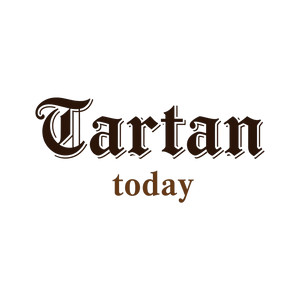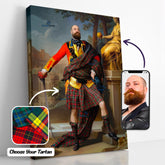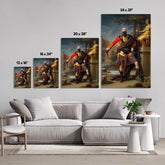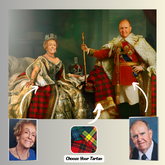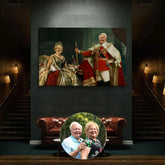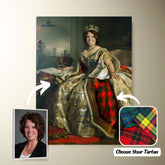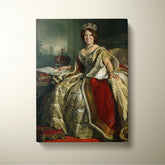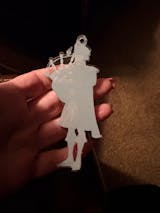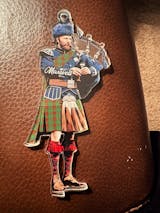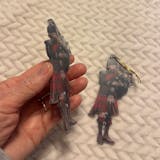-
Personalized Clan Brodie Modern Tartan Bagpipe Ornament with Custom Name – Scottish Christmas Tree Decoration TB87
Personalized Clan Brodie Modern Tartan Bagpipe Ornament with Custom Name – Scottish Christmas Tree Decoration TB87Celebrate your Scottish heritage with this unique wood & acrylic tartan ornament. Perfect as a personalized Christmas decoration or a meaningful gift for friends and relatives on special occasions...- From $19.99 USD
$25.99 USD- From $19.99 USD
- Unit price
- per
Save $6.00 -
Clan Brodie Modern Tartan Crest Star Ceramic Ornament HT47 - Brodie Modern Tartan
Clan Brodie Modern Tartan Crest Star Ceramic Ornament HT47 One of the best things about Christmas is that it gives you an excuse to dress up your home with all of the lovely ornaments we associate with the holiday season. With so many different...- From $19.25 USD
- From $19.25 USD
- Unit price
- per
-
Brodie Modern Tartan
-
Personalized Clan Brodie Hunting Modern Tartan Bagpipe Ornament with Custom Name – Scottish Christmas Tree Decoration DN83
Personalized Clan Brodie Hunting Modern Tartan Bagpipe Ornament with Custom Name – Scottish Christmas Tree Decoration DN83Celebrate your Scottish heritage with this unique wood & acrylic tartan ornament. Perfect as a personalized Christmas decoration or a meaningful gift for friends and relatives on special...- From $19.99 USD
$25.99 USD- From $19.99 USD
- Unit price
- per
Save $6.00 -
Clan Brodie Modern Tartan Crest Christmas Santa Hat OF31 - Brodie Modern Tartan
Clan Brodie Modern Tartan Crest Christmas Santa Hat OF31 Product Detail: Material: Polyester Design Area: Single side full width printing Sizes:'S (26 x 38 cm); L (32.5 x 45 cm)- From $25.41 USD
- From $25.41 USD
- Unit price
- per
-
Brodie Modern Tartan
-
Personalized Clan Brodie Modern Tartan Drummer Ornament with Custom Name – Scottish Christmas Tree Decoration VU52
Personalized Clan Brodie Modern Tartan Drummer Ornament with Custom Name – Scottish Christmas Tree Decoration VU52Celebrate your Scottish heritage with this unique wood & acrylic tartan ornament. Perfect as a personalized Christmas decoration or a meaningful gift for friends and relatives on special occasions...- From $19.99 USD
$25.99 USD- From $19.99 USD
- Unit price
- per
Save $6.00 -
Personalized Clan Brodie Hunting Modern Tartan Drummer Ornament with Custom Name – Scottish Christmas Tree Decoration OJ13
Personalized Clan Brodie Hunting Modern Tartan Drummer Ornament with Custom Name – Scottish Christmas Tree Decoration OJ13Celebrate your Scottish heritage with this unique wood & acrylic tartan ornament. Perfect as a personalized Christmas decoration or a meaningful gift for friends and relatives on special...- From $19.99 USD
$25.99 USD- From $19.99 USD
- Unit price
- per
Save $6.00 -
Personalized Clan Brodie Silver Reproduction Tartan Bagpipe Ornament with Custom Name – Scottish Christmas Tree Decoration MS43
Personalized Clan Brodie Silver Reproduction Tartan Bagpipe Ornament with Custom Name – Scottish Christmas Tree Decoration MS43Celebrate your Scottish heritage with this unique wood & acrylic tartan ornament. Perfect as a personalized Christmas decoration or a meaningful gift for friends and relatives on special...- From $19.99 USD
$25.99 USD- From $19.99 USD
- Unit price
- per
Save $6.00 -
Personalized Clan Brodie Silver Modern Tartan Bagpipe Ornament with Custom Name – Scottish Christmas Tree Decoration IT16
Personalized Clan Brodie Silver Modern Tartan Bagpipe Ornament with Custom Name – Scottish Christmas Tree Decoration IT16Celebrate your Scottish heritage with this unique wood & acrylic tartan ornament. Perfect as a personalized Christmas decoration or a meaningful gift for friends and relatives on special...- From $19.99 USD
$25.99 USD- From $19.99 USD
- Unit price
- per
Save $6.00 -
Personalized Clan Brodie Silver Ancient Tartan Bagpipe Ornament with Custom Name – Scottish Christmas Tree Decoration HM20
Personalized Clan Brodie Silver Ancient Tartan Bagpipe Ornament with Custom Name – Scottish Christmas Tree Decoration HM20Celebrate your Scottish heritage with this unique wood & acrylic tartan ornament. Perfect as a personalized Christmas decoration or a meaningful gift for friends and relatives on special...- From $19.99 USD
$25.99 USD- From $19.99 USD
- Unit price
- per
Save $6.00 -
Personalized Clan Brodie Red Reproduction Tartan Bagpipe Ornament with Custom Name – Scottish Christmas Tree Decoration HG78
Personalized Clan Brodie Red Reproduction Tartan Bagpipe Ornament with Custom Name – Scottish Christmas Tree Decoration HG78Celebrate your Scottish heritage with this unique wood & acrylic tartan ornament. Perfect as a personalized Christmas decoration or a meaningful gift for friends and relatives on special...- From $19.99 USD
$25.99 USD- From $19.99 USD
- Unit price
- per
Save $6.00 -
Personalized Clan Brodie Red Modern Tartan Bagpipe Ornament with Custom Name – Scottish Christmas Tree Decoration QI69
Personalized Clan Brodie Red Modern Tartan Bagpipe Ornament with Custom Name – Scottish Christmas Tree Decoration QI69Celebrate your Scottish heritage with this unique wood & acrylic tartan ornament. Perfect as a personalized Christmas decoration or a meaningful gift for friends and relatives on special...- From $19.99 USD
$25.99 USD- From $19.99 USD
- Unit price
- per
Save $6.00 -
Personalized Clan Brodie Red Ancient Tartan Bagpipe Ornament with Custom Name – Scottish Christmas Tree Decoration CP22
Personalized Clan Brodie Red Ancient Tartan Bagpipe Ornament with Custom Name – Scottish Christmas Tree Decoration CP22Celebrate your Scottish heritage with this unique wood & acrylic tartan ornament. Perfect as a personalized Christmas decoration or a meaningful gift for friends and relatives on special...- From $19.99 USD
$25.99 USD- From $19.99 USD
- Unit price
- per
Save $6.00 -
Personalized Clan Brodie Modern Tartan Bagpipe Ornament with Custom Name – Scottish Christmas Tree Decoration WZ13
Personalized Clan Brodie Modern Tartan Bagpipe Ornament with Custom Name – Scottish Christmas Tree Decoration WZ13Celebrate your Scottish heritage with this unique wood & acrylic tartan ornament. Perfect as a personalized Christmas decoration or a meaningful gift for friends and relatives on special occasions...- From $19.99 USD
$25.99 USD- From $19.99 USD
- Unit price
- per
Save $6.00 -
Personalized Clan Brodie Hunting Weathered Tartan Bagpipe Ornament with Custom Name – Scottish Christmas Tree Decoration OI58
Personalized Clan Brodie Hunting Weathered Tartan Bagpipe Ornament with Custom Name – Scottish Christmas Tree Decoration OI58Celebrate your Scottish heritage with this unique wood & acrylic tartan ornament. Perfect as a personalized Christmas decoration or a meaningful gift for friends and relatives on special...- From $19.99 USD
$25.99 USD- From $19.99 USD
- Unit price
- per
Save $6.00 -
Personalized Clan Brodie Hunting Reproduction Tartan Bagpipe Ornament with Custom Name – Scottish Christmas Tree Decoration LV83
Personalized Clan Brodie Hunting Reproduction Tartan Bagpipe Ornament with Custom Name – Scottish Christmas Tree Decoration LV83Celebrate your Scottish heritage with this unique wood & acrylic tartan ornament. Perfect as a personalized Christmas decoration or a meaningful gift for friends and relatives on special...- From $19.99 USD
$25.99 USD- From $19.99 USD
- Unit price
- per
Save $6.00 -
Personalized Clan Brodie Hunting Ancient Tartan Bagpipe Ornament with Custom Name – Scottish Christmas Tree Decoration PE43
Personalized Clan Brodie Hunting Ancient Tartan Bagpipe Ornament with Custom Name – Scottish Christmas Tree Decoration PE43Celebrate your Scottish heritage with this unique wood & acrylic tartan ornament. Perfect as a personalized Christmas decoration or a meaningful gift for friends and relatives on special...- From $19.99 USD
$25.99 USD- From $19.99 USD
- Unit price
- per
Save $6.00 -
Personalized Clan Brodie Dress Reproduction Tartan Bagpipe Ornament with Custom Name – Scottish Christmas Tree Decoration XW13
Personalized Clan Brodie Dress Reproduction Tartan Bagpipe Ornament with Custom Name – Scottish Christmas Tree Decoration XW13Celebrate your Scottish heritage with this unique wood & acrylic tartan ornament. Perfect as a personalized Christmas decoration or a meaningful gift for friends and relatives on special...- From $19.99 USD
$25.99 USD- From $19.99 USD
- Unit price
- per
Save $6.00 -
Personalized Clan Brodie Dress Modern Tartan Bagpipe Ornament with Custom Name – Scottish Christmas Tree Decoration UV35
Personalized Clan Brodie Dress Modern Tartan Bagpipe Ornament with Custom Name – Scottish Christmas Tree Decoration UV35Celebrate your Scottish heritage with this unique wood & acrylic tartan ornament. Perfect as a personalized Christmas decoration or a meaningful gift for friends and relatives on special...- From $19.99 USD
$25.99 USD- From $19.99 USD
- Unit price
- per
Save $6.00 -
Personalized Clan Brodie Dress Ancient Tartan Bagpipe Ornament with Custom Name – Scottish Christmas Tree Decoration VP44
Personalized Clan Brodie Dress Ancient Tartan Bagpipe Ornament with Custom Name – Scottish Christmas Tree Decoration VP44Celebrate your Scottish heritage with this unique wood & acrylic tartan ornament. Perfect as a personalized Christmas decoration or a meaningful gift for friends and relatives on special...- From $19.99 USD
$25.99 USD- From $19.99 USD
- Unit price
- per
Save $6.00 -
Personalized Clan Brodie Countryfare Reproduction Tartan Bagpipe Ornament with Custom Name – Scottish Christmas Tree Decoration CE36
Personalized Clan Brodie Countryfare Reproduction Tartan Bagpipe Ornament with Custom Name – Scottish Christmas Tree Decoration CE36Celebrate your Scottish heritage with this unique wood & acrylic tartan ornament. Perfect as a personalized Christmas decoration or a meaningful gift for friends and relatives on special...- From $19.99 USD
$25.99 USD- From $19.99 USD
- Unit price
- per
Save $6.00
Ex: Your Tartan + Product
Popular Products
Turn Me Royal Personalized Portrait from Your Photo, Custom Tartan. Custom Canvas Wall Art as Gift for Men
- From $32.45 USD
- From $32.45 USD
- Unit price
- / per
Royalty Couple Personalized Portrait from Your Photo, Custom Tartan. Custom Canvas Wall Art
- From $47.45 USD
- From $47.45 USD
- Unit price
- / per
The Queen Personalized Portrait from Your Photo, Custom Tartan. Custom Canvas Wall Art as Gift for Women
- From $32.45 USD
- From $32.45 USD
- Unit price
- / per
Which Clan Are You From?
- Apron
- Brodie
- Brodie (Graeme) Personal Ancient
- Brodie (Graeme) Personal Modern
- Brodie (Graeme) Personal Reproduction
- Brodie Black & White
- Brodie Black & White Ancient
- Brodie Black & White Modern
- Brodie Black & White Reproduction
- Brodie Black & White Weathered
- Brodie Black - White
- Brodie Black - White Weathered
- Brodie clanBrodie tartanPillow Cover
- Brodie Countryfare Ancient
- Brodie Countryfare Modern
- Brodie Countryfare Reproduction
- Brodie Dress
- Brodie Dress Ancient
- Brodie Dress Modern
- Brodie Dress Reproduction
- Brodie Dress Weathered
- Brodie Hunting
- Brodie Hunting Ancient
- Brodie Hunting Modern
- Brodie Hunting Modern Gnome
- Brodie Hunting Modern Tartan
- Brodie Hunting Reproduction
- Brodie Hunting Weathered
- Brodie Modern
- Brodie Modern Gnome
- Brodie Modern Tartan
- Brodie Red Ancient
- Brodie Red Modern
- Brodie Red Reproduction
- Brodie Red Weathered
- Brodie Silver (Brodie Muted) Ancient
- Brodie Silver (Brodie Muted) Modern
- Brodie Silver (Brodie Muted) Weathered
- Brodie Silver Ancient
- Brodie Silver Modern
- Brodie Silver Reproduction
- Brodie Tartan
- Brodie Tartan Clan
- Brodie W_A
- Scott
List Of Tartan
-
Clan A
- Abercrombie Tartan
- Aberdeen Tartan
- Abernethy Tartan
- Adair Tartan
- Adam Tartan
- Ayrshire Tartan
- Agnew Tartan
- Aikenhead Tartan
- Ainslie Tartan
- Aiton Tartan
- Allan Tartan
- Alexander Tartan
- Allardice Tartan
- Allison Tartan
- Anderson Tartan
- Angus Tartan
- Anstruther Tartan
- Arbuthnot Tartan
- Armstrong Tartan
- Arnott Tartan
- Auchinleck Tartan
- Ayrshire Tartan
-
Clan B
- Baillie Tartan
- Bain Tartan
- Baird Tartan
- Balfour Tartan
- Bannatyne Tartan
- Bannerman Tartan
- Barclay Tartan
- Baxter Tartan
- Beaton Tartan
- Bell Tartan
- Belshes Tartan
- Bethune Tartan
- Beveridge Tartan
- Binning Tartan
- Bisset Tartan
- Blackadder Tartan
- Blackstock Tartan
- Black Watch Tartan
- Blair Tartan
- Blane Tartan
- Blyth Tartan
- Borthwick Tartan
- Boswell Tartan
- Bowie Tartan
- Boyd Tartan
- Boyle Tartan
- Brisbane Tartan
- Brodie Tartan
- Brown/ Broun Tartan
- Bruce Tartan
- Buccleuch Tartan
- Buchan Tartan
- Buchanan Tartan
- Burnett Tartan
- Burns Tartan
- Butter Tartan
- Byres Tartan
-
Clan C
- Cairns Tartan
- Calder Tartan
- Callander Tartan
- Cameron Tartan
- Campbell Tartan
- Campbell of Breadalbane Tartan
- Campbell of Cawdor Tartan
- Carmichael Tartan
- Carnegie Tartan
- Carruthers Tartan
- Cathcart Tartan
- Chalmers Tartan
- Charteris Tartan
- Chattan Tartan
- Cheyne Tartan
- Chisholm Tartan
- Christie Tartan
- Clark Tartan
- Clelland Tartan
- Clephan Tartan
- Clergy Tartan
- Cochrane Tartan
- Cockburn Tartan
- Colquhoun Tartan
- Colville Tartan
- Cooper Tartan
- Couper Tartan
- Craig Tartan
- Cranstoun Tartan
- Crawford Tartan
- Crichton Tartan
- Crief District Tartan
- Crosbie Tartan
- Cumming Tartan
- Cunningham Tartan
- Currie Tartan
- Clan D
- Clan E
- Clan F
- Clan G
- Clan H
- Clan I
- Clan J
- Clan K
- Clan L
-
Clan M
- Maitland Tartan
- Malcolm Tartan
- Mar Tartan
- Marjoribanks Tartan
- Maxtone Tartan
- Matheson Tartan
- Maule Tartan
- Maxwell Tartan
- Meldrum Tartan
- Melville Tartan
- Menzies Tartan
- Mercer Tartan
- Middleton Tartan
- Moffat Tartan
- Moncrieffe Tartan
- Montgomery Tartan
- Monypenny Tartan
- Moncreiffe Tartan
- Monteith Tartan
- Morrison Tartan
- Mouat Tartan
- Moubray Tartan
- Mow Tartan
- Muir_More Tartan
- Muirhead Tartan
- Munro Tartan
- Murray Tartan
- Murray of Atholl Tartan
-
Clan Mc/Mac
- MacAlister Tartan
- MacArthur Tartan
- MacAlpine Tartan
- MacAulay Tartan
- MacBain Tartan
- MacBean Tartan
- MacBeth Tartan
- MacCallum Tartan
- MacCraig Tartan
- MacColl Tartan
- MacCorquodale Tartan
- MacDiarmid Tartan
- MacDonald Tartan
- MacDonald of Clanranald Tartan
- MacDonald of Sleat Tartan
- MacDonnell of Glengarry Tartan
- MacDonnell of Keppoch Tartan
- MacDougall Tartan
- MacDowall Tartan
- MacDuff Tartan
- MacEwen_MacEwan Tartan
- MacEdward Tartan
- MacFarlane Tartan
- MacGill Tartan
- MacGillivray Tartan
- MacGregor Tartan
- MacGowan (McGowan) Tartan
- MacHardy Tartan
- MacIan Tartan
- MacInnes Tartan
- MacIntyre Tartan
- MacKay Tartan
- MacKillop Tartan
- MacKellar Tartan
- Mackinlay Tartan
- MacKenzie Tartan
- Mackie Tartan
- MacKinnon Tartan
- MacKintosh / MacIntosh Tartan
- MacLeod Tartan
- MacMillan Tartan
- MacNab Tartan
- MacNaughton Tartan
- MacNeil / MacNeill Tartan
- MacNeil of Colonsay Tartan
- MacNicol Tartan
- MacPhail Tartan
- MacPhee_MacFie Tartan
- MacPherson Tartan
- MacQuarrie Tartan
- MacQueen Tartan
- MacRae Tartan
- MacRow Tartan
- MacSporran Tartan
- MacTaggart Tartan
- MacTavish Tartan
- MacThomas Tartan
- McCorquodale Tartan
- McCulloch Tartan
- McFadzen Tartan
- McGeachie Tartan
- McIver Tartan
- McKerrell Tartan
- Clan N
- Clan O
- Clan P
- Clan R
-
Clan S
- Sandilands Tartan
- Scott Tartan
- Scrymgeour Tartan
- Selkirk Tartan
- Sempill Tartan
- Seton Tartan
- Shaw Tartan
- Shepherd Tartan
- Sinclair Tartan
- Skene Tartan
- Skirving Tartan
- Smith Tartan
- Somerville Tartan
- Spalding Tartan
- Spens Tartan
- Spottiswood Tartan
- Stevenson Tartan
- Stewart Tartan
- Stewart of Appin Tartan
- Stirling Tartan
- Strachan Tartan
- Straiton Tartan
- Strange Tartan
- Strathclyde District Tartan
- Stuart of Bute Tartan
- Sutherland Tartan
- Swinton Tartan
- Clan T
- Clan U W Y
- Request Your Clan
Clan Brodie (Brodie Tartan)
1. About Clan Brodie (Brodie Tartan)
2. Clan Brodie History (Brodie Tartan)
The idea that the family is descended from the royal family, which bears the Pictish name "Brude," is also put forth.
The significant archaeological evidence of Pictish villages near Brodie supports this. A beautifully carved Pictish sign stone, for instance, is located not far from the castle.
Strongly committed to the Reformed religion, Alexander Brodie of Brodie (b. 1617) attacked Elgin Cathedral in 1640, destroying the carvings and paintings of the Crucifixion and Last Judgment that he deemed to be disrespectful to his faith.
In order to discuss a Scottish union with England, Cromwell summoned him to London in 1651 as part of his diplomatic career. He resisted being appointed to a position of authority, but after Cromwell's death in 1658, he had little choice but to give in.
The family eschewed participating in public events throughout the ages in favor of the stability provided by their title and residence. In her loft, Mrs. Helena Brodie of Brodie found a vellum pontifical in 1972 hidden beneath a set of Bleau atlases.
In a nutshell, it is evidence of the family's long history and a priceless historical document.
3. Clan Brodie Tartans
The Brodie tartan is reportedly from a photograph from the middle of the 18th century, but it also occurs in Sobieski Stewart's Vestiarium Scoticum from 1842 and does indeed resemble a Brothers pattern.
The dyed hues, which are typically deeper, are referred to as "modern."
K/8 R64 K32 Y4 K32 R/8 Threadcount
Brodie Modern
The Brodie Hunting tartan is mentioned in J. Claude's 1880 book, "Clans Originaux." In a very early printing of Johnston's "Scottish Clans and their Tartans," there was also a "Note by a Tartan Manufacturer" that stated: "The handsome tartan shown as Brodie is really the Hunting Brodie; the Brodie proper has a red ground." This 'of late' tartan was mentioned by D.W. Stewart in 1893. He claimed it was based on the 'earlier' dress sett and made a comment.
Brodie Hunting
4. Clan Brodie Crest & Coats of Arms
4.1 Clan Brodie Crest
Worn by all of the name and ancestry
4.2 Clan Brodie Coat of Arms
Note on Coats of Arms: A coat of arms is given to an individual under Scottish heraldic law (with the exception of civic or corporate arms). A 'family coat of arms' does not exist.
With the exclusions listed above, the weapons depicted below are personal weapons. The only person authorized to use these weapons is the grantee.
5. Clan Brodie Places & People
5.1 Clan Brodie Places
Brodie Castle
When Clan Brodie built Brodie Castle in 1567, it was demolished in 1645 by Clan Gordon under the command of Lewis Gordon, 3rd Marquis of Huntly, less than a century later.
Between 1824 and 1845, the castle underwent renovations that transformed it into the present-day castle.
The lands that the castle was built on are thought to have been given to the Brodies by King Malcolm IV in 1160. When the castle was sold to the National Trust for Scotland in 1999, nearly 800 years of Brodie ownership of the estates came to an end.
5.2 Clan Brodie People
Deacon Brodie (28 September 1741 - 1 October 1788)
William Brodie maintained a double life, working as a municipal councilor in Edinburgh during the day and a burglar at night. One of his accomplices provided King's Evidence, which led to Brodie's arrest and execution.
Most people agree that Deacon Brodie served as the model for the Dr. Jekyll and Mr. Hyde characters.
- Choosing a selection results in a full page refresh.
